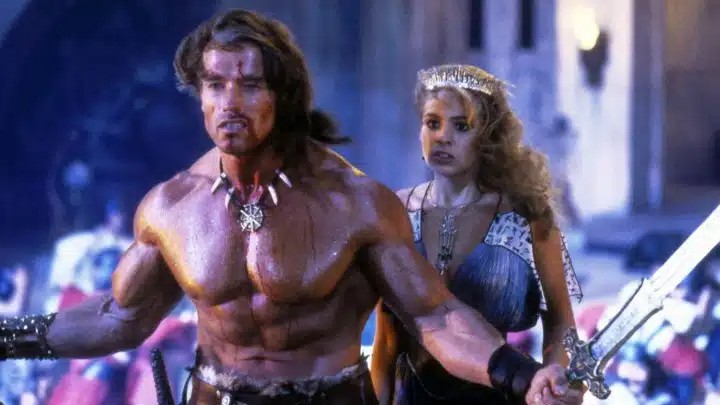
“Conan the Barbarian,” directed by John Milius and released in 1982, is a seminal film that not only defines the sword-and-sorcery genre but also showcases the evolution of cinematic storytelling in the fantasy realm. Based on the character created by Robert E. Howard in the 1930s, the film brings to life the adventures of Conan, a Cimmerian warrior played by Arnold Schwarzenegger, who embarks on a quest for vengeance and self-discovery in a brutal and mystical world. With its grand scale, memorable characters, and philosophical undertones, “Conan the Barbarian” remains a landmark film that has influenced both pop culture and the fantasy genre.
From the outset, the film establishes a mythic tone, beginning with the origin story of Conan. The narrative opens with a haunting prologue that describes the fate of his parents at the hands of the evil sorcerer Thulsa Doom, portrayed by James Earl Jones. This backstory sets the stage for Conan’s journey, establishing themes of loss, revenge, and the struggle between good and evil. The film does not shy away from depicting the harsh realities of the world in which Conan lives—one marked by violence, betrayal, and the struggle for power.
One of the film’s strengths lies in its world-building. Milius and co-writer Oliver Stone create a rich, immersive universe filled with diverse landscapes, from desolate deserts to lush forests, and a variety of cultures and creatures. The cinematography by Duke Callaghan and the stunning visuals bring Howard’s Hyborian Age to life, showcasing a world steeped in myth and danger. The use of practical effects and elaborate set designs adds a tangible quality to the film, drawing viewers into the fantastical elements of Conan’s journey.
Arnold Schwarzenegger’s portrayal of Conan is iconic and pivotal to the film’s success. Schwarzenegger imbues the character with a physicality and charisma that resonate with audiences. His performance is both primal and nuanced, capturing Conan’s evolution from a vengeful youth to a formidable warrior. The character’s journey is not only one of physical strength but also of personal growth, as Conan learns the value of friendship, loyalty, and self-discovery. Schwarzenegger’s commanding presence, combined with his delivery of minimal but impactful dialogue, cements Conan as a lasting figure in cinematic history.
The film’s narrative structure revolves around Conan’s quest for vengeance against Thulsa Doom, who has amassed power and followers through fear and manipulation. As Conan seeks to avenge his parents, he forms alliances with various characters, including Subotai, a skilled archer played by Gerry Lopez, and Valeria, a fierce warrior portrayed by Sandahl Bergman. These relationships add depth to the story, showcasing themes of camaraderie and sacrifice. Valeria, in particular, embodies a strong female presence in a genre often dominated by male characters, challenging conventional gender roles and adding complexity to Conan’s journey.

Milius’s direction brings a philosophical depth to the film, prompting viewers to ponder questions about fate, freedom, and the nature of power. The dialogue is peppered with memorable lines that resonate with existential themes, such as the famous quote, “That which does not kill us makes us stronger.” This mantra encapsulates Conan’s resilience in the face of adversity and highlights the film’s exploration of personal growth through suffering and struggle.
The score, composed by Basil Poledouris, plays a crucial role in enhancing the film’s epic quality. The powerful orchestral score, characterized by sweeping melodies and thunderous crescendos, underscores key moments of action and emotion. Poledouris’s music not only elevates the film’s intensity but also evokes a sense of nostalgia and grandeur, making it an integral part of the viewing experience. The soundtrack complements the visual spectacle, drawing viewers deeper into Conan’s world.

As the narrative progresses, Conan faces a series of trials that test his strength, both physically and morally. The film presents a variety of challenges, from battling monstrous creatures to confronting treachery among allies. Each confrontation serves as a stepping stone in Conan’s journey, contributing to his growth as a character. The climactic battle against Thulsa Doom is not only a culmination of physical conflict but also a confrontation of ideologies—brute strength versus cunning manipulation, freedom versus oppression.
In its final moments, “Conan the Barbarian” resonates with themes of destiny and the cyclical nature of life. Conan’s journey, while marked by personal loss and triumph, ultimately reflects a broader narrative about the human experience—struggling against forces beyond one’s control while striving for meaning and purpose. The film concludes with a poignant reminder of the sacrifices made along the way, leaving audiences with a sense of bittersweet reflection on the nature of victory and loss.

In conclusion, “Conan the Barbarian” is a landmark film that has left an indelible mark on the fantasy genre and popular culture. Through its rich storytelling, iconic performances, and philosophical undercurrents, the film explores themes of ambition, identity, and the human condition. John Milius’s direction, combined with Arnold Schwarzenegger’s unforgettable portrayal, creates a cinematic experience that continues to resonate with audiences today. As a tale of adventure, vengeance, and self-discovery, “Conan the Barbarian” remains a timeless classic, inviting viewers to embark on a journey through a world of magic, swordplay, and profound existential questions.

